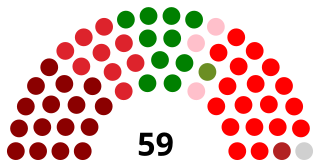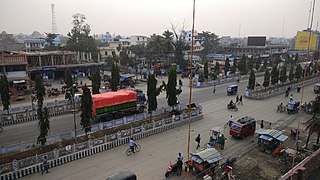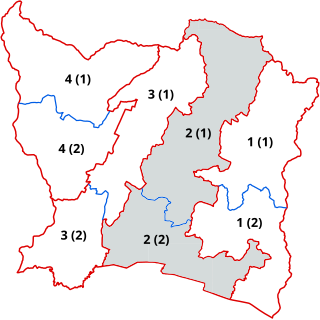Related Research Articles
The politics of Nepal functions within the framework of a parliamentary republic with a multi-party system. Executive power is exercised by the Prime Minister and their cabinet,while legislative power is vested in the Parliament.
There are three types of elections in Nepal:elections to the Federal Parliament,elections to the provincial assemblies and elections to the local government. Within each of these categories there may be by-elections as well as general elections. Currently three electoral systems are used:parallel voting for House of Representatives and provincial assemblies,Single transferable vote for National Assembly and first past the post for local elections.

The House of Representatives, or Pratinidhi Sabha is the one of the houses of the Federal Parliament of Nepal,with the other house being the National Assembly. Members of the House of Representatives are elected through a parallel voting system. They hold their seats for five years or until the body is dissolved by the President on the advice of the council of ministers. The house meets in the International Convention Centre in Kathmandu.

The National Assembly or Rastriya Sabha is the upper house of the Federal Parliament of Nepal,the lower house being the House of Representatives. The composition and powers of the Assembly are established by Part 8 and 9 of the Constitution of Nepal. There are a total of 59 members:8 members are elected from each of the seven provinces by an electoral college of each province,and three are appointed by the President on recommendation of the government.

Siraha District,a district in Madhesh Province,is one of the seventy-seven districts of Nepal. It is situated in the Terai belt of Nepal. The district,with Siraha as its district headquarters,covers an area of 1,188 km2 (459 sq mi). It has population of 637,328 according to census of 2011.The District is bordered with Saptari district in the east,Udayapur districting the north,Bihar state of India in the south and Dhanusa district in the west. Majority of the population here is Yadav,Tharus,Sahs(sahukar),Muslims and ethnic minorities with majority population speaking Maithili language and Nepali language.

The Federal Parliament of Nepal is the bicameral federal and supreme legislature of Nepal established in 2018. It consists of the National Assembly and the House of Representatives as parallel houses.
Chitra Lekha Yadav,a member of Nepali Congress,assumed the post of the Minister of Education of Nepal on 25 February 2014 under Sushil Koirala-led government.
Siraha is the headquarters and municipality of Siraha District,a part of Madhesh Province,Nepal. Siraha had a population of 28,442 according to the census of 2011. and a population of 82,531 as of 2015.The current population of Siraha municipality as of census 2022,is 96,543.It has a male population of 47,306 and female population of 49,237. The present mayor of Siraha Municipality is Dr. Nabin Kumar Yadav and Deputy Mayor is Babita Kumari Sah.Both assumed office on 25 May 2022. His predecessor mayor was Asheswor Yadav and the deputy mayor was Dr. Namita Yadav. Both assumed office on 25 September 2017 and their last working day was on 24 May 2022. The town is at 80 metres (260 ft) altitude,29 kilometres (18 mi) ESE of Janakpur.

General elections were held in Nepal in two phases on 26 November and 7 December 2017 to elect the 275 members of the fifth House of Representatives,the lower house of the Federal Parliament of Nepal. The election was held alongside the first provincial elections for the seven provincial assemblies. A political deadlock between the governing Nepali Congress and the winning left-wing coalition over the system used to elect the upper house led to delay in forming the new government. Following the announcement of final result by the Election Commission,K.P. Oli of Communist Party of Nepal was sworn in as Prime Minister on 15 February 2018 by the President according to Article 76 (2) of the constitution. He passed a Motion of Confidence on 11 March 2018 with 208 votes.
Raghubir Mahaseth is a well-renowned Nepalese politician. Mahaseth is currently serving as the Central Secretary of CPN UML,is the in-charge of the Madhesh Province of Nepal for CPN UML,and is the member of House of Representatives of the federal parliament of Nepal. He previously served as the Deputy Prime Minister and Minister of Foreign Affairs in 2021,Minister for Physical Infrastructure and Transport from 2018 to 2020,and the Minister of Irrigation in 2011.
Lila Nath Shrestha is a Nepali communist politician and a member of the House of Representatives of the federal parliament of Nepal. He was the current Minister of Law,Justice and Parliamentary Affairs and also served as Minister of Women,Children and Senior Citizens. He joined politics as a student and has remained a prominent communist politician from Siraha District. He was a candidate in the constituent assembly elections of 2013 but was defeated. He finally won his first seat in parliament in the 2017 legislative election from Siraha-3 constituency.
Padma Narayan Chaudhary (Tharu) is a Nepali politician and a member of the House of Representatives of the Federal parliament of Nepal. He was elected from Nepali Congress under the proportional representation system. Following his election to parliament,he was appointed the coordinator for the Ministry of Agriculture and Livestock in the shadow cabinet of the main opposition Nepali Congress.

Siraha 1 is one of four parliamentary constituencies of Siraha District in Nepal. This constituency came into existence on the Constituency Delimitation Commission (CDC) report submitted on 31 August 2017.

Siraha 2 is one of four parliamentary constituencies of Siraha District in Nepal. This constituency came into existence on the Constituency Delimitation Commission (CDC) report submitted on 31 August 2017.

Siraha 3 is one of four parliamentary constituencies of Siraha District in Nepal. This constituency came into existence on the Constituency Delimitation Commission (CDC) report submitted on 31 August 2017.

Siraha 4 is one of four parliamentary constituencies of Siraha District in Nepal. This constituency came into existence on the Constituency Delimitation Commission (CDC) report submitted on 31 August 2017.

General elections were held in Nepal on 20 November 2022 to elect the 275 members of the House of Representatives. There were two ballots in the election;one to elect 165 members from single-member constituencies via FPTP,and the other to elect the remaining 110 members from a single nation-wide constituency via party-list proportional representation.
Pradeep Giri was a Nepali politician from Siraha district Madhesh origin and a member of the House of Representatives from the Nepali Congress. He was also part of the party's central committee.
Raj Kishor Yadav is a Nepalese politician,belonging to the People's Socialist Party. He was Industry,Commerce and Supplies Minister of Nepal since 10 June 2021 but was removed from the post by Supreme Court on 22 June 2021 making the tenure of just 12 days and shortest till date.[3] In the 2017 Nepalese general election he was elected from the Siraha 4 constituency,securing 21144 (40.19%) votes.
References
- ↑ संघीय संसद सदस्य, २०७४ परिचयात्मक पुस्तिका [Federal Parliament Members 2017 Introduction Booklet](PDF) (in Nepali). Nepal: Federal Parliament Secretariat. 2021. p. 270.
- ↑ Election Commission of Nepal
- ↑ "Siraha – 3 | 1994 House of Representatives Election Results – Nepal Archives" . Retrieved 2021-05-12.